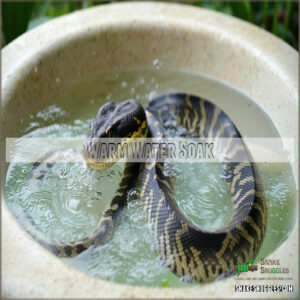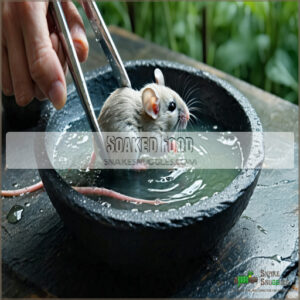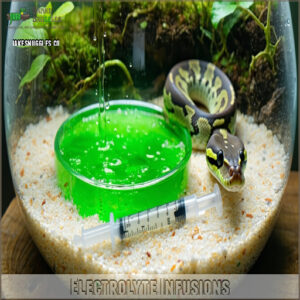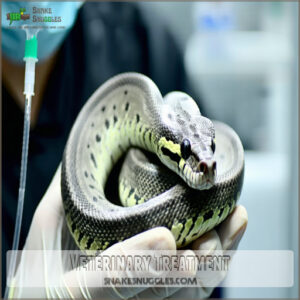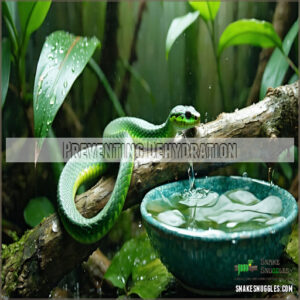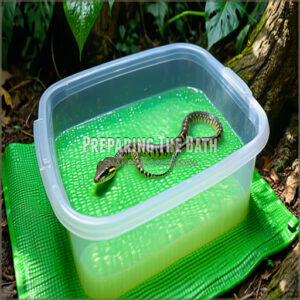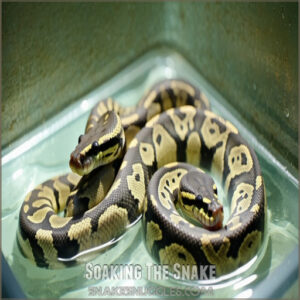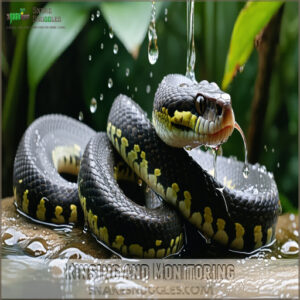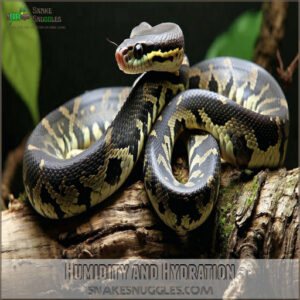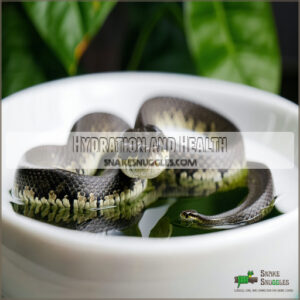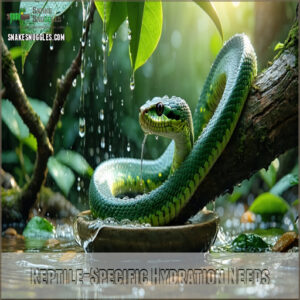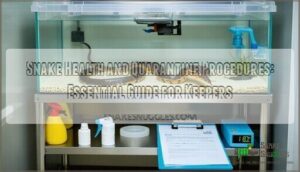This site is supported by our readers. We may earn a commission, at no cost to you, if you purchase through links.
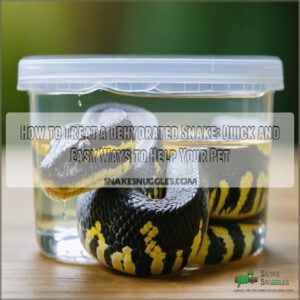 If your scaly friend’s looking a bit under the weather, you’ll need to know how to treat a dehydrated snake quickly. Watch for telltale signs like sunken eyes, wrinkled skin, or unusual lethargy.
If your scaly friend’s looking a bit under the weather, you’ll need to know how to treat a dehydrated snake quickly. Watch for telltale signs like sunken eyes, wrinkled skin, or unusual lethargy.
Give your serpent a spa day with a warm bath (82-84°F) for 15-30 minutes – just like a relaxing soak after a long day.
Boost their enclosure’s humidity to 60-70% and offer water-enriched prey.
For prevention, maintain proper humidity levels and fresh water access. Just like humans, snakes need their H2O to stay healthy, though they might not appreciate a water bottle and gym membership.
Table Of Contents
- Key Takeaways
- Dehydration in Snakes
- Rehydration Strategies
- Preventing Dehydration
- Electrolyte Baths for Rehydration
- Humidity and Hydration
- Hydration and Health
- Reptile-Specific Hydration Needs
- Frequently Asked Questions (FAQs)
- What Kind of Diet Should I Feed My Snake to Prevent Dehydration?
- What Are the Long Term Effects of Dehydration in Snakes?
- How Often Should I Check My Snake for Signs of Dehydration?
- What Temperature Should I Keep My Snake’s Enclosure to Prevent Dehydration?
- Is Dehydration in Snakes Preventable?
- How do I rehydrate my snake?
- What happens if a snake is dehydrated?
- How to rehydrate python?
- How do you save a dehydrated snake plant?
- How do I tell if my snake is dehydrated?
- Conclusion
Key Takeaways
- You’ll need to act fast when you notice dehydration signs in your snake—watch for sunken eyes, wrinkled skin, and unusual lethargy, which indicate immediate attention is needed.
- You can rehydrate your snake through a warm bath at 82–84°F for 15–30 minutes, while maintaining enclosure humidity between 60–70% and offering water-enriched prey.
- You’ll prevent dehydration by providing fresh water daily, using moisture-retentive substrates like coco husk, and monitoring humidity with a digital hygrometer.
- You must seek veterinary care if your snake shows persistent dehydration symptoms, as untreated dehydration can lead to serious complications like kidney failure and immune system problems.
Dehydration in Snakes
Dehydration in snakes is a serious issue that can lead to health complications and even death if not addressed promptly.
As a snake owner, it’s imperative to recognize the signs of dehydration and take the necessary steps to rehydrate your pet and prevent this issue from occurring.
Recognizing The Signs
Your snake’s health is a top priority, and dehydration is a serious issue.
Keep an eye out for these signs to know if your scaly friend needs a drink:
- Lethargy: Your snake’s energy levels dip, and they seem more inactive than usual.
- Eye Issues: Look for sunken, dull, or dented eyes, often paired with loose or uneven scales.
- Skin Changes: Notice dry, wrinkled skin, and flaky or brittle scales, test skin elasticity, too.
- Mouth Problems: A dehydrated snake may have a dry inner mouth and tongue, a sure sign they need a drink.
Causes of Dehydration
So, you’ve learned how to spot a dehydrated snake. Now, let’s explore why your slithery friend might be drying out.
Two big culprits are often overlooked:
- Environmental Factors: Incorrect humidity levels and temperature fluctuations can lead to dehydration. Think of it like a desert – dry air sucks the moisture right out!
- Water Quality: Sometimes, the issue isn’t access to water but its quality. Is it clean and fresh? Dry food impact can also play a role, especially for snakes in drier climates.
Recognizing snake dehydration symptoms is essential to addressing the root cause of dehydration in snakes.
Risks of Dehydration
Dehydration is no joke, and it can lead to some pretty serious health issues for your slithery pal.
It’s not just about feeling a bit dry—dehydration packs a punch with some nasty side effects.
Here are some potential risks you need to be aware of:
- Kidney failure and organ damage: Dehydration puts a lot of strain on those all-important organs, and if left unchecked, it can lead to some pretty serious and permanent damage.
- Immune system troubles: A dehydrated snake is like a fortress with a weak spot—more vulnerable to infections, especially in the eyes.
- Heartbreak: Not the romantic kind. Severe dehydration can mess with your snake’s heart, leading to potential heart failure.
- Metabolic mess: Proper hydration is key to a healthy metabolism. Dehydration throws a spanner in the works, causing all sorts of wonky imbalances.
Dehydration’s impact on a snake’s health is multifaceted, affecting various bodily systems and potentially leading to severe complications if not addressed promptly.
Rehydration Strategies
If your scaly friend is feeling a bit parched, it’s time to spring into action.
In this section, we’ll explore simple rehydration strategies to help your snake slither back to good health.
Warm Water Soak
A warm water soak is one of the simplest and most effective ways to boost your snake’s hydration.
It’s like a spa treatment for your scaly friend.
Here’s the lowdown:
- Water Temperature: Go for "just-right" temps—not too hot, not too cold.
- Aim for 82-84°F, a cozy range that mirrors their wild habitat.
- Soaking Time: Gently hold your snake in the water for 15 to 30 minutes.
- It’s their time to relax and recharge.
- Snake Swim: If your snake starts swimming, it’s a sign they’re feeling fine and the water’s just their style.
This method is a gentle, natural treatment for dehydration, and it often does the trick.
Regular rehydration strategies can help prevent dehydration in snakes and keep them healthy.
Enclosure Misting
Misting is a simple, effective way to boost your snake’s enclosure humidity.
Aim for 60-70% humidity by misting twice daily—a light rain simulation for a few seconds.
Use a spray bottle or pressure sprayer, depending on the enclosure size.
Avoid drenching the substrate.
To maintain good humidity between mistings, opt for moisture-retaining substrates like coco husk or sphagnum moss.
Soaked Food
Soaking prey in lukewarm water is a sneaky way to boost your snake’s hydration.
It’s like a spa treatment, but for their insides.
Choose prey with high moisture content and feed it often to help with water absorption.
This trick is like a secret weapon in your snake care arsenal.
- Soak prey in lukewarm water.
- Choose prey with high moisture content.
- Feed frequently to aid water absorption.
- Keep your snake happy, healthy, and hydrated.
Electrolyte Infusions
Electrolyte infusions are like giving your snake a sports drink, these drinks are packed with essential fluids and minerals like sodium, potassium, and chloride, giving your snake an extra boost to bounce back.
You can add these to their drinking water or give them a warm bath with an electrolyte solution, just make sure to use reptile-safe electrolytes and follow the instructions.
This method is awesome if your snake is dealing with muscle weakness or having trouble eating, for best results, consider using a reptile electrolyte supplement to support your pet’s overall health and hydration.
| Infusion Method | Pros | Cons |
|---|---|---|
| Drinking Water | Easy to administer | May not be as effective for severe dehydration |
| Warm Bath | Faster absorption | Requires more preparation |
Veterinary Treatment
If your snake’s dehydration isn’t budging, seek veterinary intervention.
They’ll diagnose the dehydration, checking for underlying issues. Vets offer fluid therapy for quick rehydration and reptile medication for infections.
Treating a dehydrated snake this way can prevent long-term problems like: 1. Kidney failure, 2. Liver damage, 3. Heart problems, 4. Weakened immune system, 5. Death.
Emergency care, including snake hospitalization, may be necessary. Your vet is your ally in snake dehydration treatment to provide emergency care.
Preventing Dehydration
Keeping your slithery friend happily hydrated is simple.
Provide fresh water, maintain 60-70% humidity, and regulate their enclosure temperature to prevent dehydration.
Also, use moisture-retentive substrates and monitor your snake’s weight, skin, and behavior for any changes.
Providing Fresh Water
Keeping a steady supply of fresh water is key to preventing dehydration.
Make sure your snake always has access to a water bowl with clean water—change it daily, and avoid distilled water, as it lacks minerals.
Keep an eye on water temperature, too; it should be comfortable for your snake, and you can monitor their drinking behavior with a digital hygrometer.
Just remember, a healthy snake is a happy snake, and a happy snake is a hydrated snake, and having access to clean water is crucial for this, making fresh water a vital component.
Maintaining Optimal Humidity
How’s the humidity in your snake’s home?
Aim for 60-70% to keep dehydration away.
Grab a hygrometer to monitor moisture levels and mist regularly.
Go for moisture-loving substrates like coco husk or sphagnum moss.
A humid hide can be a snake’s happy place, offering extra hydration.
It’s all about keeping those moisture levels just right for your scaly friend’s health and happiness.
Using a hygrometer device is essential for maintaining the ideal environment.
Regulating Temperature
Now we’ve got the humidity down pat, let’s dial in on temperature. It’s a delicate balance, but these tips will help you steer clear of any extremes.
Here’s the lowdown on keeping your snake’s enclosure comfortably warm:
- Use heating pads and basking spots to create a thermal gradient.
- Snakes like options—provide a range of temperatures to keep them comfy.
- Monitor the ambient temperature closely to confirm it doesn’t get too hot.
Insulate the enclosure to maintain a comfortable climate.
Keep a keen eye on temperature fluctuations to guarantee your snake’s comfort and safety.
Using Moisture-Retentive Substrates
Choosing the right substrate is key to keeping your snake’s home humid and healthy.
Go for moisture-retentive substrate materials like coco husk or sphagnum moss.
These natural options help maintain humidity levels, ensuring your pet stays properly hydrated.
For a thorough guide, explore the best substrate options for your ball python’s specific needs.
Avoid dry substrates like sand or wood shavings, which can worsen dehydration.
By selecting a moisture-retentive substrate, you’re creating a safer, more comfortable environment for your snake to thrive.
Regular Monitoring
Beyond the substrate setup, your snake’s health hinges on regular monitoring.
Track their weight weekly and watch for behavior changes like reduced activity, log daily water intake and skin condition – wrinkles or stuck shed are red flags.
Check humidity levels twice daily and note any eye changes, catching dehydration early makes treatment way easier, so keep those health observations consistent, focusing on regular monitoring and behavior changes.
Electrolyte Baths for Rehydration
You’ll be amazed at how quickly an electrolyte bath can perk up your dehydrated snake, working like a sports drink to restore essential minerals and fluids.
Just like you’d need more than plain water after an intense workout, your scaly friend needs a specially prepared bath that’ll help them bounce back to their healthy, active self.
Preparing The Bath
Now that you’ve spotted dehydration, let’s set up the perfect bath for your scaly friend.
Grab a plastic container that’ll give your snake room to stretch out. You can find suitable reptile bath containers online.
Fill it with lukewarm water (80-85°F) – just enough to cover their body.
For an electrolyte soak, mix 75% sports drink with 25% water. Pop a heat pad underneath and let it warm up for 15 minutes.
Soaking The Snake
Right into your snake’s warm water soak you’ll go! Keep the water temperature between 82-85°F for ideal comfort.
- Place your snake gently in the electrolyte soak.
- Support their body while they explore the water.
- Maintain soaking duration for 15-30 minutes.
- Watch for signs of stress or discomfort.
Your snake might even enjoy this hydration method – think of it as their personal wellness retreat!
Rinsing and Monitoring
After your snake’s finished their electrolyte bath, give them a gentle rinse with lukewarm water for about 30 seconds.
Keep an eye out for these key signs during the next few days:
| What to Watch | What it Means |
|---|---|
| Skin elasticity | Bounces back quickly = good hydration |
| Activity level | More movement = improving |
| Scale appearance | Smooth, not wrinkled = hydrated |
| Eating habits | Regular feeding = recovery |
| Eye condition | Clear, full eyes = well hydrated |
Humidity and Hydration
You’ll need to keep your snake’s humidity levels between 60-70% to prevent dehydration, which can lead to dreaded wrinkled scales and stuck sheds.
Just like you wouldn’t want to spend a day in the Sahara without water, your scaly friend needs the right moisture balance in their home to stay healthy and active.
Importance of Humidity
After those invigorating electrolyte soaks, let’s explore how humidity levels work like your home’s natural air conditioning system. Your snake relies on ideal humidity to stay healthy, just like tropical plants in a greenhouse. Think of humidity as nature’s way of keeping your pet comfortable.
- Imagine dewdrops dancing on fresh leaves in the morning
- Picture a misty rainforest after a gentle shower
- Envision scales gleaming with natural moisture
- Think of your pet gliding through air as soft as silk
Getting these humidity effects right keeps your snake thriving, just like in their wild habitat .
Monitoring Humidity Levels
Keeping track of humidity levels is like being a weather forecaster for your snake’s home. Install a digital hygrometer in a central spot of the enclosure – it’s your most reliable tool for measuring humidity fluctuations.
Research your snake’s specific needs for ideal health, as different snake species have unique humidity preferences.
Create humidity gradients by placing your misting system strategically, and use moisture-retentive substrates to maintain suitable humidity between 40-60% . Add a humid hide for extra moisture control.
Check readings twice daily. If levels drop, a quick mist will keep your scaly friend comfortable.
You can learn more about ideal snake tank humidity on the Snakesnuggles website.
Hydration and Health
You’ll be surprised to learn that your snake’s health depends heavily on proper hydration, as it affects everything from organ function to successful shedding.
Just like you need water to keep your body running smoothly, your scaly friend needs the right balance of moisture to prevent serious issues like kidney failure and heart problems.
Impact of Dehydration on Health
Beyond dry scales, dehydration in snakes triggers a chain of serious health issues.
Like a car running on empty, metabolic disruption affects your pet’s entire system.
They’ll face shedding difficulties and immune suppression, making them vulnerable to infections. Even their body’s most basic functions start faltering – think of it as their internal engine sputtering.
What starts as simple thirst can quickly snowball into major snake health issues .
Organs Affected by Dehydration
When your pet loses too much water, it’s more than just feeling thirsty – dehydration wreaks havoc on their important organs. Think of it like a domino effect through their body.
Here’s what happens inside your dehydrated snake:
- Their kidneys struggle to filter waste, leading to kidney problems.
- The liver slows down, making it harder to process nutrients.
- Their heart has to work overtime, risking heart problems.
- Muscles weaken, affecting movement and digestion.
- The immune system takes a hit, leaving them vulnerable to illness.
What’s scary is that organ damage can start before you notice external signs. Keep their water fresh and humidity right to protect those precious organs.
Long-Term Effects of Dehydration
Let’s examine what happens when dehydration drags on in your snake. Chronic dehydration can trigger a cascade of underlying issues, from serious organ damage to heart problems.
Your snake’s kidneys might struggle, and their growth could slow down. Watch for shedding difficulties – they’re often a red flag for metabolic issues.
Without proper hydration, your snake faces reduced lifespan and increased risk of chronic illness. Think of water as your snake’s lifeline – it keeps every system running smoothly.
Reptile-Specific Hydration Needs
You’ll need to adjust your hydration approach based on your reptile’s specific needs.
Arboreal geckos prefer licking water droplets, while semi-aquatic reptiles need both wet and dry areas.
Just like you wouldn’t serve coffee to your toddler, you’ll want to match your pet’s hydration method to their natural drinking habits.
Whether that’s shallow soaks for tortoises or misting for tropical species.
Arboreal Geckos
Tree-dwelling geckos sip up life differently than other reptiles, showing unique licking behavior regarding hydration.
- Set up a quality misting system to create the perfect droplet size for drinking.
- Maintain steady humidity levels between 50-80% with daily misting.
- Provide a shallow dish of filtered water for backup hydration.
Your arboreal gecko’s water sources should match their natural habits. Here’s how to nail their humidity preferences:
Tortoises
Unlike arboreal species, tortoises need regular soaking sessions in shallow, tepid water.
A quick 15-20 minute soak, just covering their shell’s bottom edge, works wonders for hydration.
Mist your tortoise’s enclosure daily to maintain 40-60% humidity, and always keep fresh water available.
Toss in moisture-rich foods like cucumber or watermelon as tasty hydration boosters – your shelled friend will thank you!
Bearded Dragons and Leopard Geckos
Desert dwellers like bearded dragons and leopard geckos have unique water requirements compared to other reptiles.
While they don’t drink much directly, you’ll need to keep their metabolic needs in mind during brumation hydration. Try supplementing fluids by misting their enclosure or creating humidity gradients with a shallow water dish. For dehydrated reptile care, gently drip water on their snouts – they’ll often lick it right up!
Proper reptile nutrition care(reptile nutrition) is essential for maintaining their overall health and preventing dehydration.
Semi-Aquatic Reptiles
Looking after semi-aquatic reptiles like Brazilian Rainbow Boas and Water Snakes means mastering the art of combined hydration. Your scaly friend needs both dry and wet zones to thrive.
Here’s what works for these moisture-loving creatures:
- Create distinct zones: 70% water area, 30% basking spots
- Install a reliable filtration system for crystal-clear water
- Use moisture-retaining substrate like coco husk or cypress mulch
Remember, proper humidity gradients are key to preventing dehydration in these unique pets.
Frequently Asked Questions (FAQs)
What Kind of Diet Should I Feed My Snake to Prevent Dehydration?
Like a thirsty sponge, your snake needs moisture-rich prey. Feed pre-soaked frozen/thawed rodents, avoid dry prey, and offer fresh water daily. You’ll keep your scaly friend hydrated and happy.
What Are the Long Term Effects of Dehydration in Snakes?
You’ll face serious health issues if your snake stays dehydrated: organ failure, digestive problems, and even death. Their kidneys can shut down, and they’ll struggle with shedding and eating properly.
How Often Should I Check My Snake for Signs of Dehydration?
Check your snake’s skin elasticity, eyes, and behavior weekly during regular maintenance.
Pay extra attention during shedding periods or when the humidity drops below ideal levels in their enclosure.
What Temperature Should I Keep My Snake’s Enclosure to Prevent Dehydration?
Imagine your snake basking in perfect comfort.
Maintain 75-85°F (24-29°C) at the cool end and 88-92°F (31-33°C) at the basking spot.
You’ll need 60-70% humidity to prevent moisture loss.
Is Dehydration in Snakes Preventable?
You can prevent snake dehydration by keeping fresh water available. Maintain 60-70% humidity and use moisture-retaining substrates.
Monitor your snake’s weight and behavior. Regular check-ups help catch early signs of dehydration.
How do I rehydrate my snake?
You’d be surprised—your snake isn’t playing hard to get!
Soak them in lukewarm water (82-84°F) for 15 minutes.
Mist their enclosure twice daily and offer pre-soaked prey for quick rehydration.
What happens if a snake is dehydrated?
Your snake’s body starts shutting down when dehydrated. You’ll notice wrinkled skin, sunken eyes, and lethargy.
Without proper water, they’ll struggle to move, shed, and eat.
They could face organ failure if untreated.
How to rehydrate python?
When your scaly friend’s feeling parched, give them a lukewarm bath (82-84°F) for 15-30 minutes.
Maintain 60-70% humidity for ideal hydration. Mist their enclosure twice daily.
How do you save a dehydrated snake plant?
You’ll need to water the snake plant thoroughly from the bottom up.
Place the pot in a tray with water.
Let it soak for 15 minutes, and avoid overwatering in the future.
How do I tell if my snake is dehydrated?
Like a deflated balloon, your snake’s skin might look wrinkled or loose.
You’ll notice sunken eyes, dry scales, reduced activity, and difficulty shedding.
Watch for a lack of skin elasticity during gentle pinch tests.
Conclusion
Regarding treating a dehydrated snake, you’re better safe than sorry.
By staying vigilant and addressing symptoms early, you’ll keep your serpentine friend healthy and thriving. Proper humidity, regular soaks, and fresh water access are your best allies in preventing dehydration.
If your snake shows persistent signs of dehydration despite your efforts, don’t hesitate to consult a reptile vet. After all, your scaly companion depends on you for their well-being.
- https://www.snakesforpets.com/how-to-treat-a-dehydrated-snake/
- https://thepetenthusiast.com/dehydrated-ball-python/
- https://reptifiles.com/ball-python-care-guide/ball-python-diseases-health/dehydrated-ball-python/
- https://animalcityinc.com/blog/47117/help-i-think-my-reptile-is-dehydrated
- https://savethereptiles.wordpress.com/2010/01/06/dehydration-in-reptiles-signs-causes-and-treatment/


